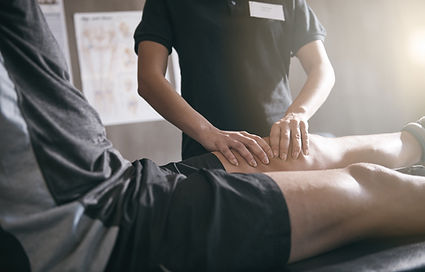Chiropractic - Acupuncture
Active Release Techniques

Services Offered

Chiropractic Adjustments & Mobilizations
Manual chiropractic adjustments (also called joint manipulation) are safe, highly skilled procedures, in which the chiropractor's hands and body are used to apply a quick force to a specific joint. This can be performed at the joints in the spine or limbs. Chiropractic adjustments are used to restore joint motion, reduce muscle stiffness, and decrease pain; effects that are often immediate.
Adjustments will often produce an audible popping noise (the sound heard when knuckles are 'cracked'). This noise is created by a change in joint pressure, which causes the release of gas within the joint.
While manual adjustments are a very safe procedure, they are not suitable in all situations, or for all patients. A thorough examination will determine whether you are a good candidate for manipulation. Alternative treatments, such as joint mobilizations, can be used in place of an adjustment.

Rehabilitative Exercise
Exercise is an essential part of the treatment process because movement, and lack of movement, are often the cause of pain or injury. Your posture and movement patterns will be assessed to determine movement deficiencies that can be targeted with precise exercises.
Your individual goals will be taken into consideration when an exercise plan is designed, whether they be rehabilitation from injury, prevention of injury, optimizing health, or enhancing performance. Movement is essential for pain management, optimal functioning, and performance. Joints need motion, muscles need strengthening, and tendons require the proper load to maintain health.

Nutrition & Supplement Recommendations
Just as food has the power to cause illness, it can also be used as a powerful medicine. You might be surprised to learn that there are foods that can increase pain, and foods and supplements that can reduce pain.
Your treatment plan may incorporate individualized nutrition and supplement recommendations. Lifestyle changes can be incredibly difficult and everyone is on their own path towards health and wellness. You will receive guidance that takes into consideration where you are on that path, so you can make realistic changes to enhance your health.


Soft Tissue Therapy
Soft tissue therapy is a form of manual therapy that involves work on the muscles, tendons, ligaments, nerves, and fascia. It is typically used to reduce muscle tension, but can also be used to normalize muscle and joint action. The end result is improved function and reduced pain.
Active Release Techniques (ART) is the gold-standard soft tissue therapy used to treat elite athletes. ART is a highly effective treatment for injuries and pain caused by repetitive activities. This technique incorporates massage, muscle contraction, joint motion, muscle stretching, and nerve mobilization in order to reduce pain and restore proper biomechanics. ART practitioners undergo recertification on a yearly basis, which ensures practitioners continually refresh and enhance their treatment skills.
There are several other soft tissue treatment techniques that may be used during your treatment. These include trigger point therapy, therapist-assisted stretching, and instrument assisted soft tissue mobilization.

Contemporary Medical Acupuncture
Acupuncture is an ancient treatment method used for musculoskeletal pain and dysfunction. It involves the insertion of solid fine needles into specific anatomical locations. Electricity or manual manipulation of the needles results in stimulation of local nerves. This produces a wide-range of physiological changes in the body, which result in modulation of abnormal function of the nervous, endocrine/exocrine, or immune systems.
In a chiropractic setting, acupuncture is commonly used to reduce pain, improve blood flow, promote healing, and normalize neuromuscular function. It can be used to treat a wide-range of conditions including chronic pain, repetitive injuries, athletic injuries, sprains/strains, carpal tunnel syndrome, and headaches.

Orthotics and Bracing
In some situations, the body may benefit from extra support. Braces are typically used to support an injured area during the healing process. Some conditions that braces can be used for include ankle sprains, knee sprains, tennis elbow, or carpal tunnel syndrome.
Customized orthotics may be useful for managing chronic lower extremity pain. They can also be useful in situations where there is an anatomical variation, such as bowing of the legs, or high and rigid arches of the feet. A thorough examination including a gait analysis and gait scan will be used to determine if orthotics may be beneficial to you. If it is determined that you are a good candidate for orthotics, a scan of your feet will be taken and sent to a lab to produce orthotics customized to your exact feet.
Education
Patient education is a crucial aspect of the treatment plan. Research has demonstrated that education regarding a medical condition or injury results in better outcomes for patients. Education will typically include topics, such as the mechanism/cause of injury, the likely outcome of the injury, and things you can do to manage pain.
One of Dr. Erin's greatest joys is empowering patients and members of her community to take charge of their own health. Becoming informed is the first step towards making the changes necessary to improve one's health and quality of life. Unfortunately, it can be difficult to sift through the wealth of information available to us in the modern technological age. Dr. Erin is happy to discuss health-related topics with her patients to ensure they are receiving evidence-informed information.
Also, check out the for some great information...